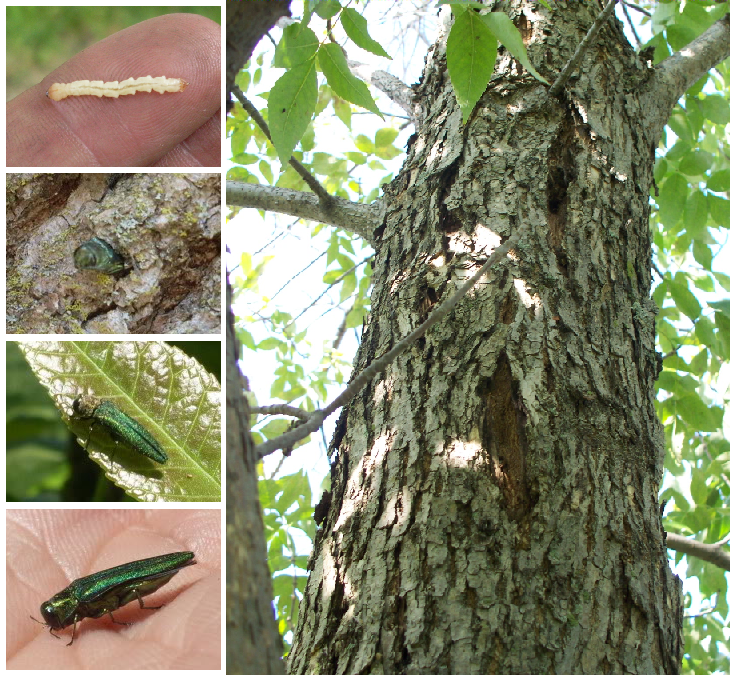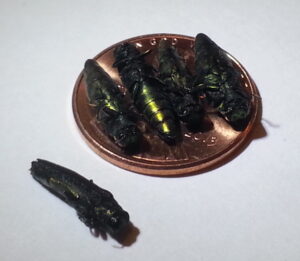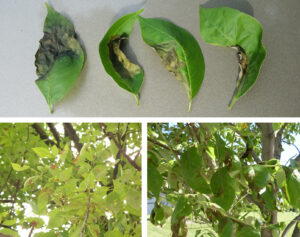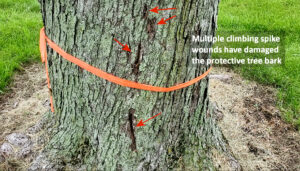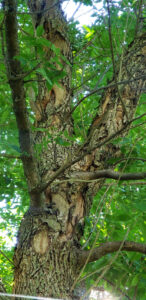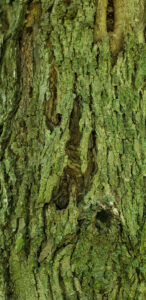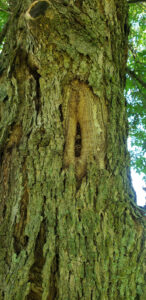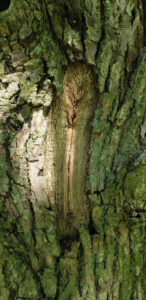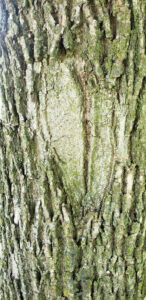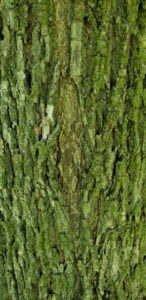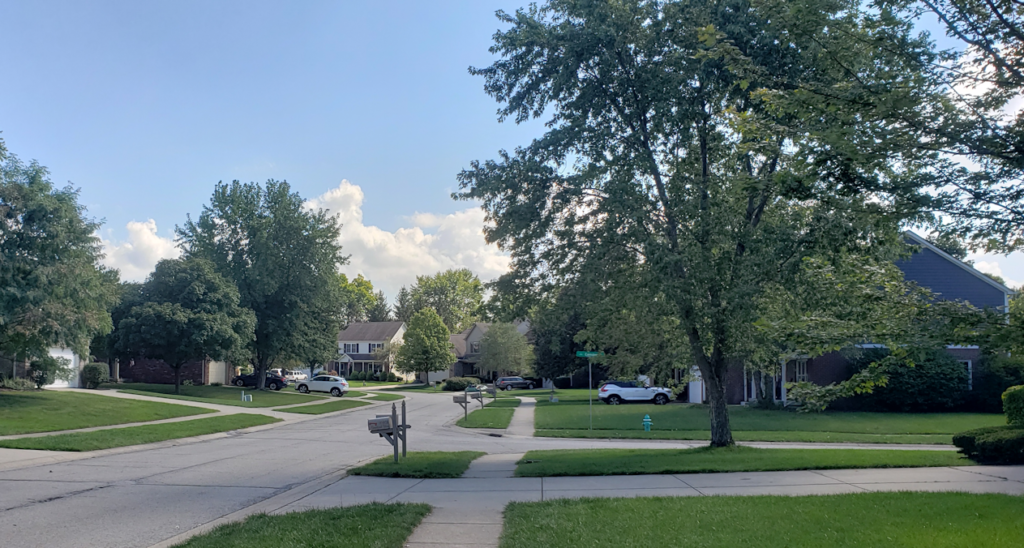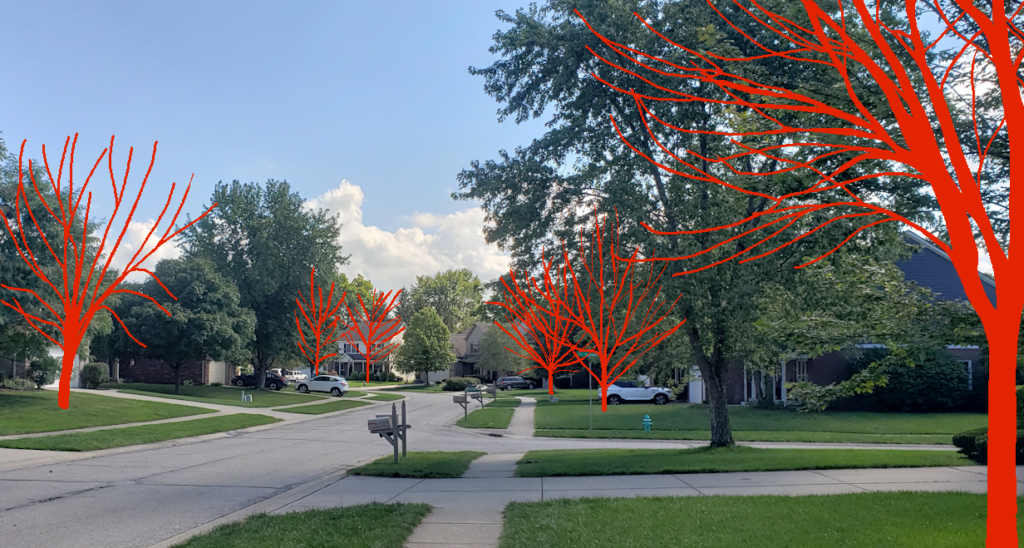
[Last update: November 2025]
Quick Links to Topics Covered in This Article:
INTRODUCTION • What About EAB Today?
Host Identification • Signs & Symptoms
Pest Identification • “Is It Too Late?”
Post-Injection Expectations • Additional Resources
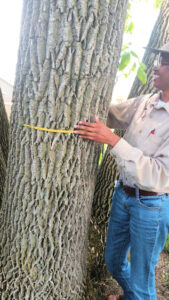
Common abbreviations used in this article:
EAB – Emerald Ash Borers, PHC – plant health care, AC# – Ash canopy condition rating number
Unless otherwise cited, all illustrations and photographs used in this article are by Jeff Harris or Jaira Harris. © Arbor Rangers, LLC
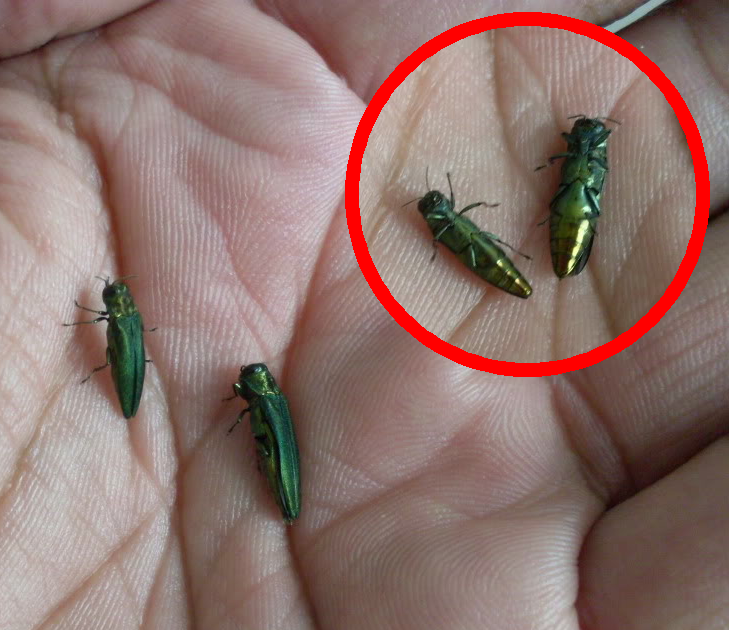
Exhibit A: The adult male EAB (left in photo and inset) are naturally smaller than female EAB. (Click to enlarge.)
INTRODUCTION
The sharp decline and deaths of hundreds, then thousands, of Ash trees in Michigan prompted an investigation where the Emerald Ash Borer (Agrilus planipennis Fairmaire, also referred to by its acronym EAB) was identified in the summer of 2002. These exotic stowaways arrived in the United States from international shipping crates and packing materials from Asia. By 2009 these devastating pests had spread to 11 states (including Indiana) and were also found in adjacent parts of Canada, killing more than 50 MILLION unprotected Ash trees (Fraxinus spp.). Unsurprisingly, the number of states affected increased to 14 states by the following summer (Exhibit B)!
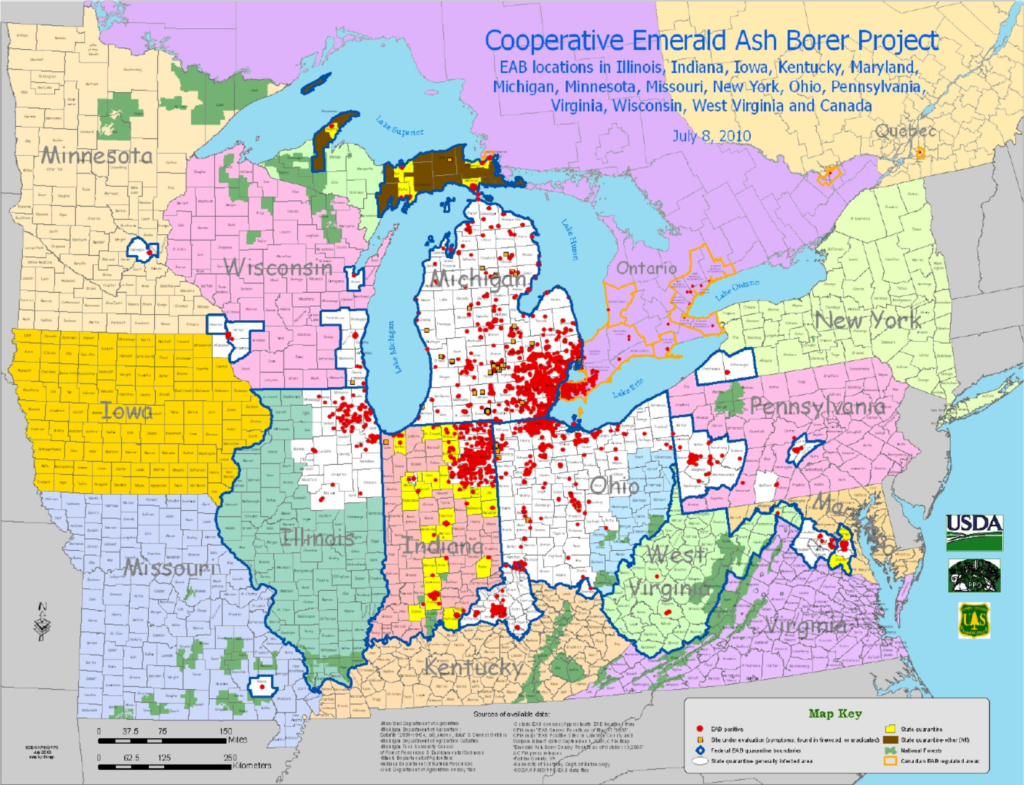
Exhibit B: THEN – Nearly eight years after their discovery in 2002, this was the situation as of July 8, 2010, over a decade ago. Multi-state EAB locations data was collected by USDA-APHIS. Diagram map © 2010 USDA-APHIS
WHAT ABOUT EAB TODAY?
Nearly two decades have passed and many weary property owners in the Midwest are wondering if they should still be concerned about EAB? Whether you have been treating your Ash trees over the years to control this exotic pest or not, there will always be a risk of re-infestation as long as…
→ you still have Ash trees on your property.
→ EAB are still present within a 30-mile radius of your Ash trees.
As of JANUARY 2021, the number of US states reporting EAB infestations is 35, along with the Canadian provinces of Ontario, Quebec, New Brunswick, Nova Scotia, and Manitoba. (Exhibit C) The cumulative Ash tree death toll is estimated to run into the HUNDREDS OF MILLIONS!
EAB infestations were also confirmed in White Fringetrees (Chionanthus virginicus) in 2014 and in cultivated Olive trees (Olea europea) in 2015. The EAB was first observed attacking White Fringetrees in Ohio during the summer and fall of 2014, with formal confirmation occurring shortly after. Researchers then began testing the beetle’s ability to infest Olive trees, with initial lab experiments showing a potential to attack them in 2015.
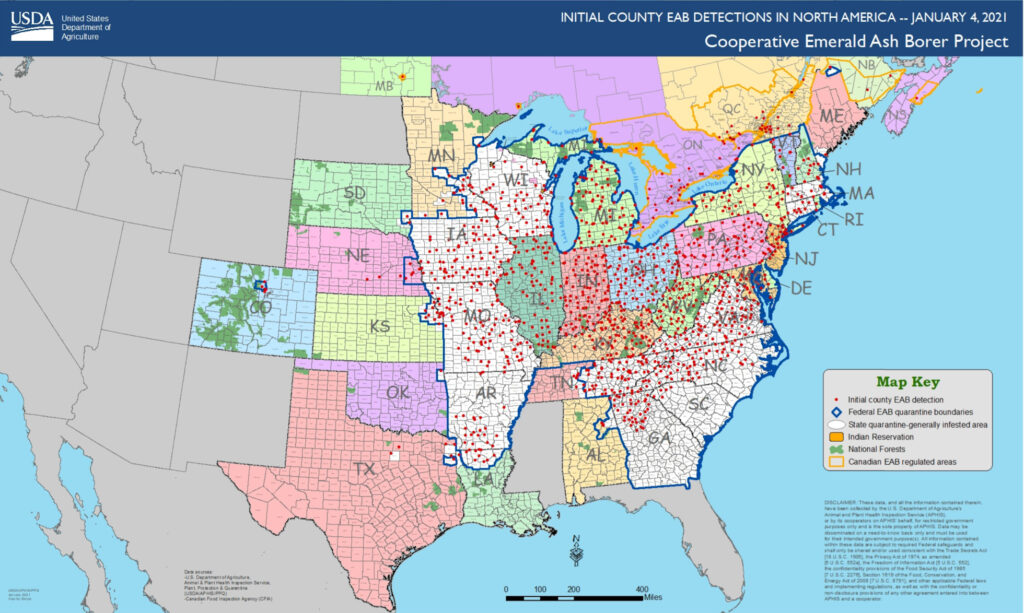
Exhibit C: NOW – This is the situation as of January 4, 2021, nearly 19 years after their initial discovery in Michigan back in 2002. Multi-state EAB locations data was collected by USDA-APHIS. Diagram map © 2021 USDA-APHIS (Click to go to image on USDA site.)
If you have never had your Ash trees treated to control EAB before or they haven’t been treated in several years (and are not beyond saving), the first step in EAB control management is to ensure you’ve properly identified the host plant (e.g. true Fraxinus species more widely known as Ash trees). You also need to familiarize yourself with the signs and symptoms associated with EAB infestations, along with getting to know how to identify this invasive species (or hire an ISA Certified Arborist to inspect your trees. An experienced arborist can help identify problems negatively impacting the health of your trees and may offer advice on your plant health care (PHC) options.
Scientific studies have shown that untreated Ash trees that become infested by EAB have a 100% mortality rate. Therefore, the old saying, “An ounce of prevention is worth a pound of cure,” would definitely apply in this instance. Treating your Ash trees now may save you the worry of losing them later. At this time, the MOST EFFECTIVE and best products available to kill EAB contain the active ingredient Emamectin Benzoate (developed by Syngenta) and commercially distributed for licensed pesticide applicators under various brands. To assist Ash tree owners in their decision-making, Dr. Cliff Sadof, (Entomologist, Purdue University) has created an invaluable online tool, the Emerald Ash Borer Cost Calculator that helps estimate out-of-pocket expenses associated with Ash management strategies over a 25 year period. The proper timing of any PHC application is critical in achieving maximum pest control.
HOST IDENTIFICATION
ASH TREES (Fraxinus spp.)
The following information applies mostly to Indiana residents, but the Ash trees described may be common in other Midwest and surrounding regions as well.
Sometimes Ash tree ID comes down to which of the types is native to the area, but keep in mind that transplanted trees from nurseries may be rare or non-native to Indiana. In most instances, however, your best guess based on your field experience and knowledge of local Ash trees is the way to go. Even if you get the exact type of Ash wrong, you are sure to get the species correct. And from a PHC viewpoint, when it comes to disease & insect control specific to species that’s really what’s going to count most!
Pumpkin Ash can be found in small pockets statewide, but they are most prevalent in the southwestern counties. Its swollen base earns it its name.
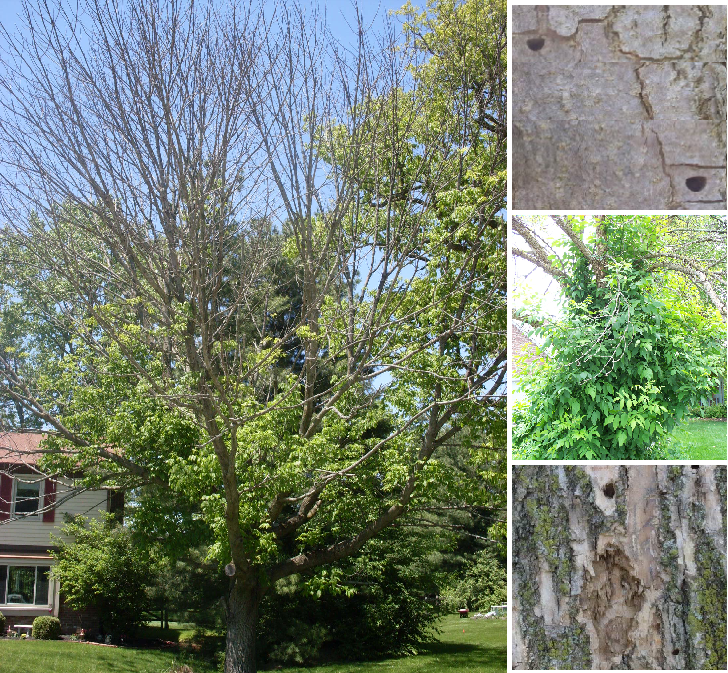
Exhibit D: EAB infestation signs & symptoms include Ash tree decline (loss of leaves, dieback of twigs & branches, watersprouts, and “D-shaped” borer exit holes. (Click to enlarge.)
SIGNS & SYMPTOMS
Here are some things to look for…
(Refer to Exhibits D through F)
- Canopy Dieback and Thinning of Foliage from Upper Crown Downward
- D-Shaped Exit Holes
- Epicormic Shoots (aka Watersprouts)
- Vertical Bark Splits with many revealing S-Shaped Larval Galleries
- Increased Woodpecker Activity Resulting in Visible Bark Damage
Note: Some of these symptoms are very similar to those caused by other insect and disease pests or site and climate conditions which to the untrained eye could mistakenly be attributed to EAB. Sometimes several combined factors are involved. It is recommended to seek the aid of an experienced ISA Certified Arborist to more accurately diagnose your PHC concerns.
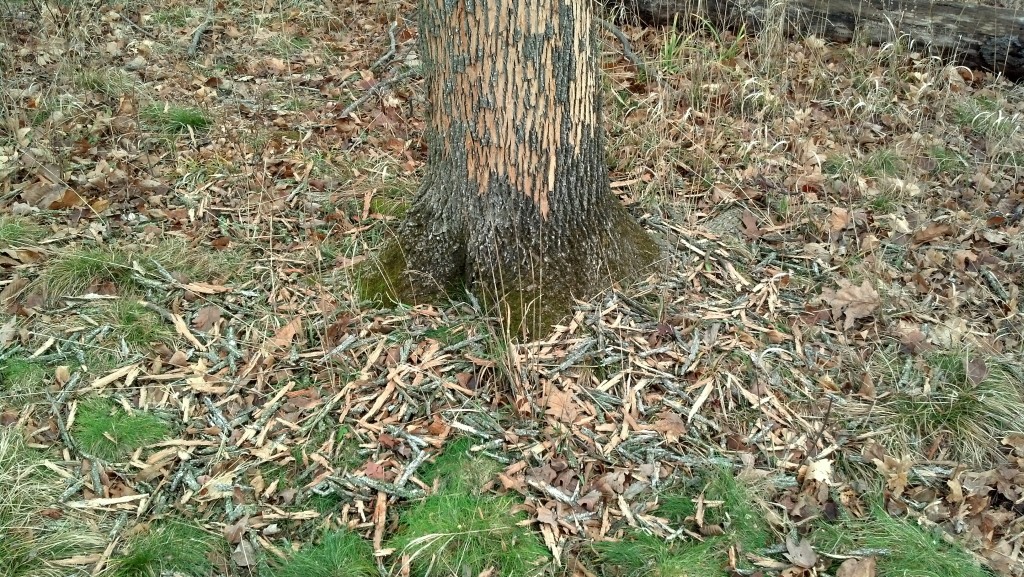
Exhibit E: The bark of this infested Ash tree has been stripped by hungry woodpeckers in search of EAB larvae underneath. (Click to enlarge.)
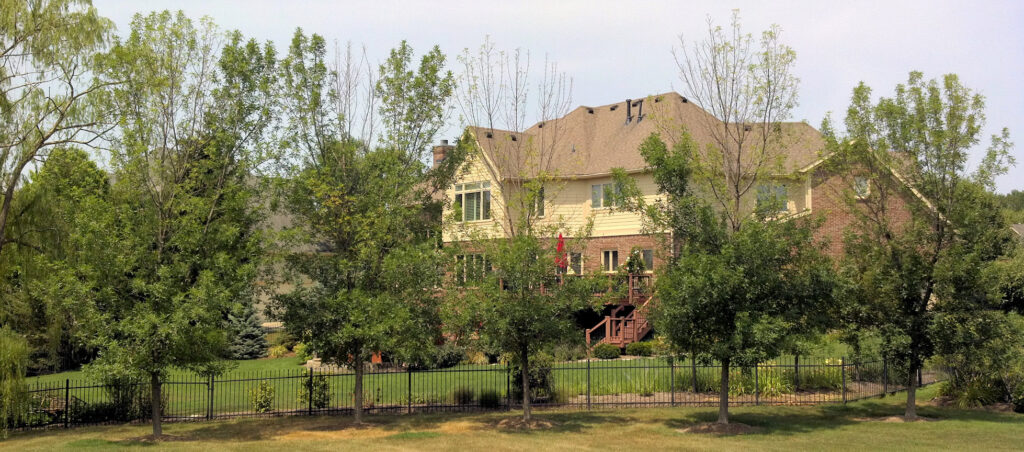
Exhibit F: Severe EAB damage to a row of Green Ash trees in West Carmel, Indiana (July 2012). (Click to enlarge.)
PEST IDENTIFICATION
Emerald Ash Borer
Agrilus planipennis Fairmaire
Also, see Native Ash Borers and Emerald Ash Borer Look-alikes by Michigan State University Extension and the Emerald Ash Borer Look-Alike chart by the University of Nebraska.
- EAB Eggs
- Are laid in the cracks and crevices of Ash tree bark
- Darken to a brownish color in about 3 to 4 days
- Hatch in about 7 to 19 days, depending on location and environmental conditions
- EAB Larva
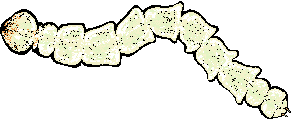
- Reach a length of 26 to 32 mm.
- Creamy White Flattened Bodies
- Bell-Shaped Segments
- No Legs or Prolegs
- 4 Growth Stages
- Feed on outer sapwood (Phloem) and Cambium layers under bark
- Feeding pathways (galleries) are serpentine (S-shaped) patterned
- Pre-pupal larvae excavate a deeper chamber to overwinter and pupate
- EAB Pupa
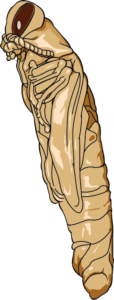
- Are about 11–16 mm in length.
- Mature in about 20 days
- Overwinter under tree bark
- EAB Adult Beetle
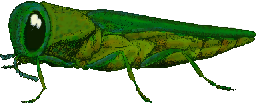
- Are 7.5 to 13.5 mm in length and four can fit onto a penny (Exhibit G)
- Winged Insects
- Irridescent Metallic Green Exoskeletons
- Slender Bodies
- Feed on Ash (Fraxinus spp.) leaves
- Females Larger than Males (Exhibit A); live an average of 20 days after emerging
- Females may lay up to about 100 or more ivory-colored eggs during her lifetime
- Males live an average of 22 days after emerging
EAB typically have a one-year life cycle. Adult beetles will begin emerging from Ash trees around mid to late May to early June. A good timing indicator for EAB emergence is to watch for Black Locust trees (Robinia pseudoacacia) blooming in your area.

Exhibit I: Black Locust trees (Robinia pseudoacacia) in bloom usually coincide with the time when EAB begin emerging from Ash trees in the area. A reminder: EAB attack only true Ash species (Fraxinus spp.) and very rarely White Fringetree (Chionanthus virginicus), but not Black Locust trees. (Click to enlarge.)
“HOW CAN I TELL IF IT’S TOO LATE TO SAVE MY ASH TREES?“
The Ash Canopy (AC) Condition Rating System
The Ash canopy condition rating system was developed through the collaborative efforts of the Department of Biological Sciences (University of Illinois at Chicago) and the USDA Forest Service (Northern Research Station) in 2014, further expanding the extensive research by Annemarie Smith, B.S. (Ohio State University, 2006). It is recommended to seek the aid of an experienced ISA Certified Arborist who can evaluate your Ash trees.
This rating system helps PHC providers to visually assess the amount of Ash tree canopy decline and dieback, ranging from 1 (full and healthy) to 5 (no leaves, or essentially dead). It is useful as part of the decision-making process to have your Ash trees treated or not.
1 (AC1) = Canopy is full and healthy
2 (AC2) = Canopy has started to lose leaves (thinning), but no dieback (dead top canopy twigs without leaves) is present
3 (AC3) = Canopy has less than 50% dieback
4 (AC4) = Canopy has more than 50% dieback
5 (AC5) = Canopy has no leaves, epicormic sprouts may be present on the trunk
Here are a collection of photos we’ve taken over the years that demonstrate each of the five states of canopy decline as graded using the Ash Canopy Condition rating system.
“I’ve had my Ash trees treated but they seem to be getting worse and more limbs are dying and the bark is starting to come off!”
Take a deep breath. There. Now before you go off and fire your PHC provider, be sure you are not mistaking natural recovery progression with bad or misapplied service! Think back to when you first had your trees treated. Prior to any EAB control treatment what were your Ash trees rated? Keep in mind that other factors, such as a fungal disease, can cause the AC# rating to be higher due to increased leaf loss from the infection as well as EAB infestation.
• AC3: Canopy loss ranged from 25% up to 50% therefore treating your trees involved a degree of risk for failure and you should keep your expectations low. On the other hand, there have been a few success stories. Think of why you went ahead and had your Ash trees treated despite their rating. (Caution: The potential danger of injury or damage from falling dead limbs onto nearby pedestrians or property from AC3-rated trees should have been evaluated along with other precautions and recommendations from your PHC provider. Some property owners may elect to take move forward with treatment because of the importance of their Ash trees, such as:
› sentimental value
› landscape asset value
› etc.
• AC4 or higher: Canopy loss was extremely high ranging from 50% on up. You should not have had your Ash trees treated and your PHC provider should have recommended removal instead. The extent of vascular damage was too great and therefore treatment was bound to fail since the control product could not reach necessary areas throughout your trees to stop the feeding EAB larvae from doing further damage.
“WHAT CAN I EXPECT FOLLOWING INITIAL EAB CONTROL TREATMENT?”
This section is about expectations and keeping them realistic following initial trunk injections for EAB control, assuming that it was properly administered by an experienced PHC provider and that there was good uptake of the active ingredient. Success also depends upon the cultural practices YOU contributed following the treatment or that were provided for you by your PHC provider or landscape professional.
Bear in mind that protecting your Ash trees from EAB will take commitment on your part and on the part of your dedicated PHC provider. It will be a journey of patience and trust. The recovery of your valuable Ash trees depends upon it! This is NOT a one or two-time treatment then you’re done situation, however, when compared to the cost and loss of removing your Ash trees your investment in trying to save them is typically well worth the time and effort. (See Emerald Ash Borer Cost Calculator, Dr. Cliff Sadof, Entomologist, Purdue University, and his easy-to-follow Decision Guide.) Let’s take a look at a typical cycle of EAB management and an Ash tree’s recovery process…
YEAR ONE [INSPECTION & INJECTION YEAR]
Ash trees are inspected. Ash trees rated AC1 – AC2 (up to 25% overall crown loss) and some trees rated AC3, barring any other negative factors* or circumstances usually qualify for trunk injection of Emamectin Benzoate (active ingredient), with client approval. After successful uptake into healthy vascular tissue, the months following injections will allow the formulation to translocate to vulnerable live plant tissue. Research by Purdue University Extension has found after 15 years of study that traces of the active ingredient may persist in the woody tissue for up to three years, however pesticide labels will state up to two years. Your trees will experience plant stress from their EAB injuries. These internal injuries will cause a loss of foliage and twigs and limbs to decline and dieback. Some may have already died and these will require pruning. Stress is further exacerbated when temperatures reach or exceed 89º F, therefore irrigating your Ash trees IS A MUST! Keeping your Ash trees adequately hydrated during drought periods is critical to their recovery and directly affects the efficacy of treatment! Your Ash trees should NOT be injected when temperatures exceed 89ºF for prolonged periods, regardless of irrigation, to minimize phototoxicity.** Your trees can wait on treatment until temperatures drop a bit if you keep them sufficiently watered. Regarding pruning… Try to postpone pruning until the next year to allow more recovery time for your Ash tree. Sometimes limbs may appear dead but have instead gone dormant. It would be a shame to remove live limbs accidentally. Certain dead limbs may pose an obvious risk of causing personal injury or property damage and should be removed ASAP. Epicormic shoots should not be pruned, if possible. These are your trees’ natural lifelines and should remain for now as they will provide supplemental means for photosynthesis during this recovery period. Also, do not apply any fertilizers this year to your treated Ash trees as this may add further stress to them! (Explained further in YEAR TWO).
*A common fungal disease, Anthracnose, will cause infected Ash leaves to brown, shrivel, and drop prematurely particularly as temperatures heat up. It may be harder to distinguish infected leaves from leaves that are dying from dehydration caused by EAB larvae injuries to the tree stems’ vascular tissue. Ash Anthracnose is not usually considered a lethal disease, nor does it typically require any fungicide treatment, but it can cause your Ash tree to look extremely sickly. Leaf abscission of even secondary (replacement) foliage is likely to occur during prolonged rainy seasons which may result in a higher infection rate. Therefore be aware that this disease, coupled with an EAB infestation, can sometimes cause the AC# rating evaluation to be higher (e.g. AC3, instead of AC2).
**Phototoxicity can occur by applying too high of a dose of treatment of Emamectin Benzoate so be VERY careful not to overdose! Sometimes what appears to be the correct dose is thwarted because the vascular tissue damage is more than expected and so the product is limited to only a few areas of the Ash tree. This can create an overdose in those areas. Matters are made worse the higher the temperature gets and if there is little to no precipitation. Fungal leaf diseases can exacerbate the situation, but do not confuse phototoxicity with these sorts of infections. Both of these conditions may occur concurrently. Additionally, don’t allow desperation to save a tree, nor emotion, to blur your judgment when treating an EAB-infested Ash tree. It takes years of field experience to know how much and when to use Emamectin Benzoate properly, always following the product label. That is why it is recommended that you hire an experienced ISA Certified Arborist. Studies have proven that a little Emamectin Benzoate goes a long way in stopping EAB larval feeding! (Refer to the research results cited concerning Emamectin Benzoate on page 12 in the section, Trunk-injected Systemic Insecticides of the Insecticide Options for Protecting Ash Trees from Emerald Ash Borer publication produced through the collaborative efforts of several universities.)
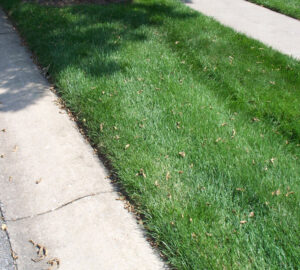
This is some of the leaf litter from a White Ash tree that resulted from phototoxic leaf dieback just a couple of days following trunk injections of Emamectin Benzoate to control EAB. (Click to enlarge.)
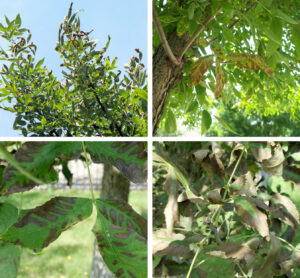
These are some examples of White and Green Ash trees that experienced phototoxicity after they were injected with too much Emamectin Benzoate for EAB. (Click to enlarge.)
YEAR TWO
Significant EAB larvae control should have been achieved, as well as broader protection from new invaders. The two-year period of protection provides your trees much-needed relief from aggressive EAB larvae feeding and offers your treated Ash trees a critical time to recover from their EAB injuries. Adequate watering is critical! “Should I fertilize my tree this year?” No. Even mildly infested trees undergo a degree of stress. Fertilizers within the first two years of recovery may add unnecessary additional stress. Recovering trees utilize their energy towards sealing wounds and producing compensating foliage. It takes energy to metabolize fertilizer nutrients and fertilizers, in general, and particularly during periods of drought, can dry out your treated trees disrupting recovery. “Will I see a difference this year?” In general, no. As a matter of fact, you should expect to see some DECLINE in your trees’ overall appearance, including further dieback of limbs! Keep in mind that your Ash trees were ALREADY infested for many years before they began to show significant signs of decline. By that same line of reasoning, it will take time for treated Ash trees to show significant results. Patience is definitely required, along with good watering habits. What we look for during the year following treatment is the emergence of new growth. The tree should start partially callusing (sealing) over the exposed wounds where its bark splits. Epicormic shoots will continue to emerge to compensate for lost limbs and foliage. Epicormic shoots should not be pruned at this time for the same reason as explained in YEAR ONE. About pruning… Unless there are obvious dead limbs present posing a risk of injury or damage then try to wait to prune your Ash on year three. You may need to discuss with your Homeowners Association (HOA) these instructions as part of the recovery process, but be prepared to comply with their requirements to have your trees pruned for community aesthetics.
YEAR THREE [INSPECTION & INJECTION YEAR]
Ash trees that were treated two years prior are inspected again are due for re-treatment to continue protecting them from new EAB infestation. You should continue to see the development of new growth (healthy buds, flowers, twigs, etc.). Some new epicormic shoots may naturally appear but perhaps not as vigorously as before, especially if tree stress is being managed through timely irrigation. We should see more evidence that the tree is successfully callusing over old wounds (internally it will continue compartmentalizing injuries). Don’t be too alarmed if large patches of bark loosen and begin to fall off the trunk and limbs. This usually reveals the tunneled etchings of former EAB larvae. This is a completely natural tree response! Foliar growth rates may vary throughout the canopy and it is again vital to ensure trees receive enough irrigation, particularly during drier and hotter climate periods. Most limbs that were beyond saving are now dead or are very, very near death and will stand out more. This is not an indication that the treatments have failed. It’s an indication of how bad off your tree was suffering before you had them treated. This too is natural. If you haven’t already, you may have maintenance pruning performed during this year as these dead limbs will make them easier to identify and distinguish from limbs that have survived. Pruning can be done almost any time after early spring, but try to get it done during the growing season which will allow the tree some time to start sealing those pruning wounds before it goes dormant in the fall. Try to leave a few Epicormic shoots if the canopies of your trees are still a little thin to provide more active leaf material for photosynthesis.
YEAR FOUR (and BEYOND)
Internal EAB activity in your treated Ash trees should be extremely minimal or null. Your trees are in full recovery mode. If you haven’t had maintenance pruning performed on your tree yet, the dead limbs will be even more pronounced and there may be some breakage in these areas. You may still see some Epicormic shoots forming but some of these may occur naturally and not due to stress or EAB. Prune these according to the overall live crown ratio to always maintain a healthy amount of working foliage while avoiding excessive crossover branches. You may also notice that more old bark has loosened on the trunk and limbs over areas where EAB larvae did damage underneath. EAB galleries will become more exposed and visible as this bark falls off, which may appear troubling to see at first. You should direct your focus and note the plant tissue swelling around these wound areas. This is an excellent indicator that your recovering Ash trees are continuing to put energy towards sealing these wounds. Note the process of recovering from wounds through the series of bark photos below. (Click each for a larger view.) Congratulations! Your Ash trees are progressing well on their road to recovery. You should see steady improvement year after year, provided no other PHC concerns creep in to disrupt their progression, like girdling roots. You MUST maintain good cultural practices, like providing sufficient irrigation and avoiding volcanic mulching, etc. Contact your PHC provider at the first sign of trouble to try to help you to mitigate these issues if possible before they become worse. Infection by fungal leaf pathogens, such as Anthracnose mentioned in section YEAR ONE, can cause your trees to look bad, so don’t confuse this condition as a sign that the EAB control treatments aren’t working.
The Three-Year Treatment Cycle – Although Emamectin Benzoate is typically labeled to protect for up to two years, recall our earlier mention concerning Research by Purdue University Extension after 15 years of study. They found traces of the active ingredient that persisted for up to three years within the woody tissue of the treated Ash trees they were monitoring. Therefore, at the discretion of your PHC provider and based on the density of untreated Ash trees in your area, the level of EAB infestation, and the extent that your tree has recovered, they may recommend changing how frequently your Ash trees are treated by replacing the every-second-year treatment cycle with an every-third-year cycle. (Example: You are on a two-year treatment cycle. Your Ash trees were last treated in 2020 and are not due for their next injections until 2022 (i.e. two years later). On that 2022 service visit, your PHC provider determines that your Ash trees appear to be in remarkable condition and that most of their wounds have sealed. This prompts the PHC provider to put your trees on a three-year treatment cycle. Therefore, after the 2022 injections are completed, the next set of injections will not be scheduled until 2025 (i.e. three years later).
Exhibit K: At first glance, the appearance of the bark may be upsetting or even alarming following EAB control treatment, but in actuality, this is exactly what we want to see happening!
Exhibit L: As your treated Ash trees experience far less EAB larvae activity as the Emamectin Benzoate stops the pests’ feeding, your trees gain a measure of relief as they seal over their EAB injuries. Since the original bark’s underlying phloem and cambium layer were badly damaged from EAB larval feeding, it dies over each internal wound. The natural response is to compartmentalize the wounds and to form new callous tissue to seal these wounds. As a result, the old bark will loosen from the tree and begin to flake away in small or large sections depending on the areas affected by each wound.
Exhibit M: In most cases, after the old bark has flaked off this will reveal the damage below. Serpentine (winding S-shaped) feeding paths or galleries were carved as the EAB larvae fed on the phloem and cambium layers beneath the bark. The swollen appearance of the areas surrounding these wounds as discussed before is reactive wood produced in response to injury. When your treated Ash trees use energy to seal over their wounds, this can be a positive indicator that the tree has the vigor for new tissue development. Therefore, it is vital that recovering Ash trees receive sufficient water to help them maintain that vigor!
Exhibit N: Upon successful closure, the sealed wound area will have a puckered, closed-mouth-looking surface. This is worth celebrating because now the interior deadwood will not be as exposed, thus reducing the opportunities of invading wood-destroying organisms such as decay fungi and Carpenter Ants. You may still have to contend with hungry woodpeckers that can damage the new bark while in search of larvae remnants.
Exhibit O: As the new bark ages, you will notice its transition over time blend in more with the bark in areas that were not damaged severely by EAB larvae simply because that is exactly what is happening! These restored areas are going to continue to develop and grow with the rest of the tree. As each new annual growth rings develop underneath it will soon be difficult to identify where the original wounds were.
Exhibit P: Here is a near-complete restoration of a former EAB wounded area. In time, following diligent care and treatments to control EAB, almost every exposed wound will be sealed just like this one on your treated Ash trees! Just be patient and take note of this amazing recovery process!
DON’T PUT TREATMENT OFF ANY LONGER
Remain vigilant. The likelihood of total eradication of EAB is slim to impossible, but the situation is not hopeless, even for areas that have already lived past the initial wave of devastation. Count yourself fortunate if you reacted in time to have your Ash trees treated and they are still around today for you to tell about it. In some astonishing cases, there are a few Ash trees that have somehow dodged death and survived (so far) that were never treated. Upon closer inspection, however, you will see at least some sign of EAB injury. If you want to save your Ash trees, do not take further chances by delaying treatment. Contact a professional and experienced PHC provider and have your Ash trees treated to protect them from severe EAB infestation. It’s only a matter of time before all untreated Ash trees suffer their demise by this invasive exotic beetle. Let’s hope your Ash trees aren’t among them!
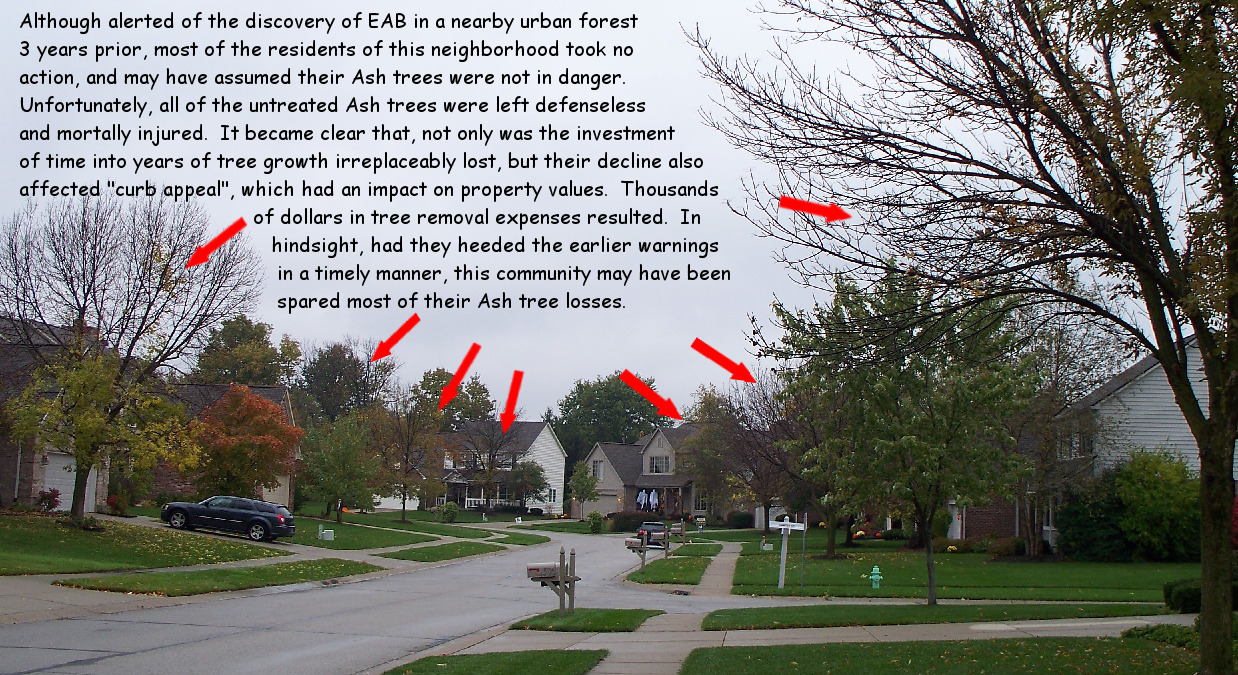
Exhibit Q: An EAB infestation in a Fishers, IN, neighborhood. The first confirmed finding was made by ISA Certified Arborist Mike Webster (IN-1480 B) back in 2009. Unfortunately, many property owners had not heeded the DNR alerts to treat their Ash trees and as a result, most of the trees shown in this photo had to be removed. (Click to enlarge.)
Our friend, Mike Webster, has since become an ISA Board Certified Master Arborist and is working for Arbor Care Tree and Landscaping. Mike has a wealth of knowledge and experience and we couldn’t be more proud of him!
Here’s that same Fishers neighborhood 12 years later in 2021. Although it lost many Ash trees, many of the younger Maple trees in 2009 have grown larger and some of the dead Ash trees were replaced. Still… It’s interesting to image how much more beautiful this area could have looked like if those Ash trees had survived and become more mature.
A reminder of the Ash trees lost…
DON’T FORGET TO WATER YOUR TREES!
ADDITIONAL EAB RESOURCES ONLINE
- Why Hire An Arborist? – International Society of Arboriculture
- Purdue University Extension – Emerald Ash Borer in Indiana
- Emerald Ash Borer Information Network
- USDA-APHIS Emerald Ash Borer Program Manual
- Colorado Emerald Ash Borer First Responder Manual
- New York Invasive Species Information – Emerald Ash Borer: Biology and Life Cycle
Be sure to check your local government and Extension office websites for EAB information directly affecting your area and please, if you go camping or engage in any other outdoor activity using a campfire, fire pit, bonfire, or fireplace, please avoid transporting fire logs across county lines. Beware of EAB hitchhikers! Burn it in the local area you buy it or gather it from.
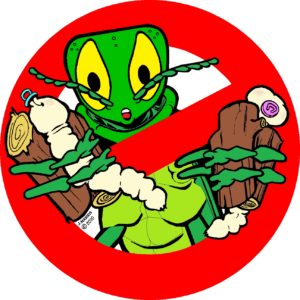
EAB eggs and larva may be on the firewood you use. Help slow the spread of EAB and don’t transport firewood across county lines! (Click to enlarge.)
• Arborist Services Terms and Conditions • Terms of Use • Privacy Policy •

